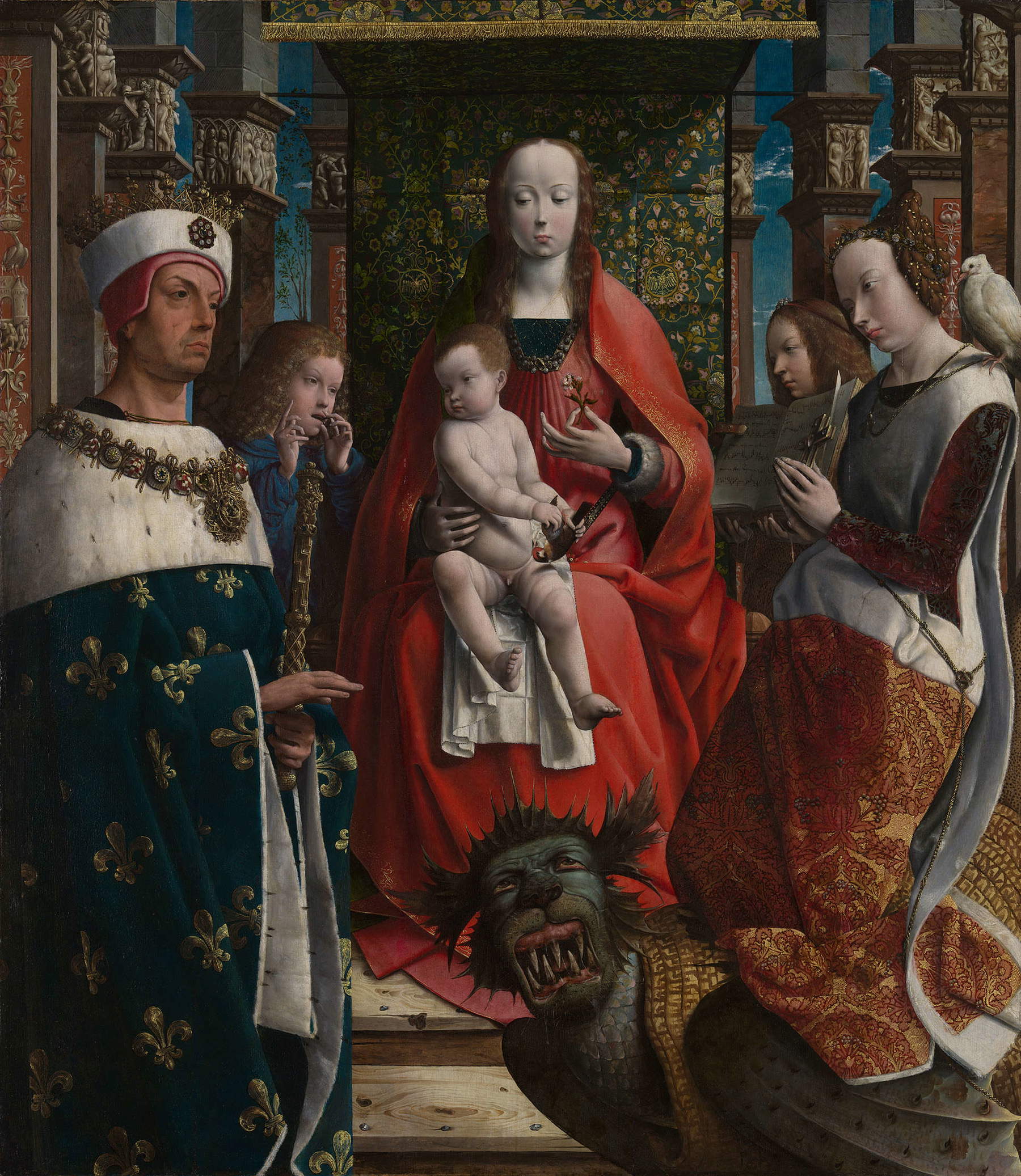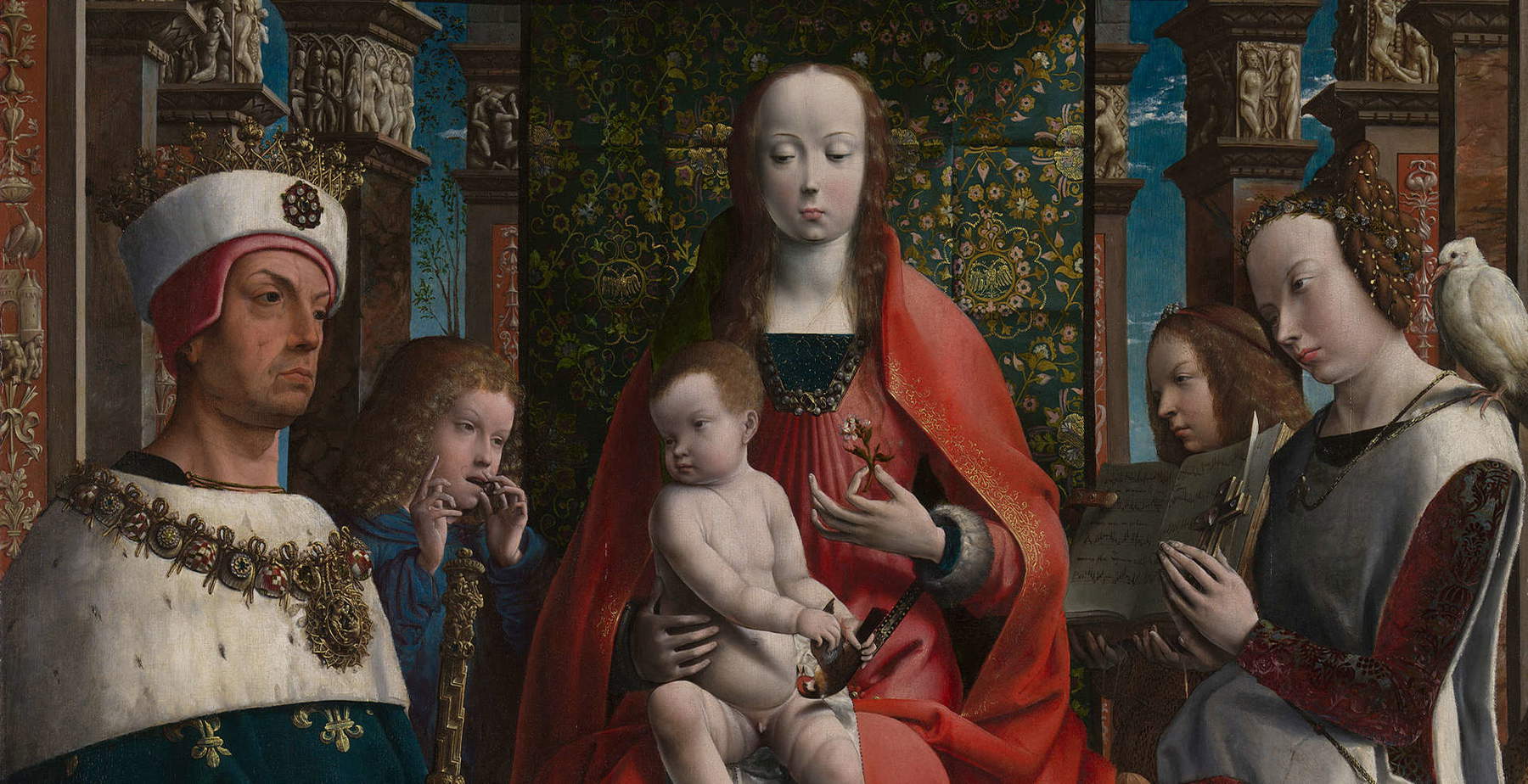As part of its bicentennial celebrations, the National Gallery in London announced the acquisition of an extraordinary and mysterious Northern Renaissance altarpiece, dated around 1510, that had not been on public display for more than 60 years. The work, a Virgin and Child with Saints Louis and Margaret, whose author is unknown, was acquired from a private collection through a confidential negotiation brokered by Sotheby’s auction house, with a total value of £16.4 million, thanks to the support of the American Friends of the National Gallery.
The altarpiece will be officially unveiled to the public starting May 10, 2025, at the opening of the new Sainsbury’s Wing as part of the major exhibition project CC Land: The Wonder of Art, the most ambitious remounting of the museum’s collections ever.
At the center of the painting stands the enthroned Virgin and Child, surrounded by two musician angels, Saint King Louis of France, and Saint Margaret, rising intact from the broken shell of the dragon that swallowed her. The iconographic details are numerous and surprising: one of the angels plays a curious mouth harp, an unusual instrument in the celestial context, while the other holds an open book engraved with verses from the Marian hymn Ave Regina Caelorum. The musical notation, however, appears imaginary, a sign of poetic license rather than liturgical transcription.
Refined architectural elements are glimpsed in the background, as well as singular and out-of-the-ordinary presences: prominent among them is the scene carved on a capital, in which a mischievous child shows his butt. An ironic detail that contrasts with the sacred aura of the work and testifies to the inventive freedom of the anonymous author. No less significant are the darker elements, such as the bare steps and nail heads that symbolically foreshadow Christ’s future sacrifice.
The attribution of the work remains uncertain and debated. The painting displays stylistic features that have raised questions among art historians about its geographical origin: some clues suggest a Dutch hand, while others seem to lean toward a French school. The Baltic oak support, a material most frequently employed by artists from the Netherlands, seems to reinforce the Nordic hypothesis. However, the rendering of volumes, the monumentality of the figures, and the dramatic use of light and shadows also suggest the French painting tradition of the time, particularly the work of the Master of Moulins, Jean Hey.

There is no shortage of comparisons with known authors: the general composition, the presence of fantastical elements and the eccentricity of the expressions hark back to the early production of Jan Gossaert, who was active in the first decades of the 16th century and was already present in the National Gallery collections with theAdoration of the Magi. Other possible references include the meticulousness of Jan van Eyck and the emotional intensity of Hugo van der Goes, but also the narrative and plastic implications typical of late 15th-century French painting.
The painting is first documented in 1602 at the urban priory of Drongen, near Ghent, in present-day Belgium, a circumstance that further supports the Flemish hypothesis. Dendrochronological analysis of the wooden panel confirms that the support was carved from an oak tree felled after 1483. In addition, the depiction of the chain of the Order of St. Michael worn by St. Louis, still with the double “aiguillettes” knots that would only be modified in 1516 under Francis I, allows the painting to be dated to before that year.
The identity of the author, however, remains unknown, a circumstance that thus defies the (very bad) habit of tying the value of a work to the name of its creator. It is precisely in this anonymity that one of the work’s most intriguing qualities lies: it demonstrates how, in the late Middle Ages and Renaissance, great art could manifest itself even outside the known circuits of official patronage and large workshops.
For the National Gallery, this acquisition represents a significant moment within the celebration of the two hundredth anniversary of the museum’s founding, which will fall between 2024 and 2025. The Virgin and Child with Saints Louis and Margaret joins a list of important additions to the London collection that have occurred in recent months: including Sir Lawrence Alma-Tadema’s After the Audience, Nicolas Poussin’sEucharist, and Eva Gonzalès’s The Full-length Mirror. The entry of the anonymous altarpiece thus reinforces the encyclopedic and inclusive vocation of the National Gallery, which continues to expand its holdings by welcoming works of the highest artistic caliber, regardless of the notoriety of the author. With this work, the London museum therefore not only unearths a masterpiece forgotten for more than 60 years, but invites the public to rediscover the wonder of art as a living experience, beyond signatures and names.
 |
| London, National Gallery acquires mysterious Northern Renaissance altarpiece |
Warning: the translation into English of the original Italian article was created using automatic tools. We undertake to review all articles, but we do not guarantee the total absence of inaccuracies in the translation due to the program. You can find the original by clicking on the ITA button. If you find any mistake,please contact us.